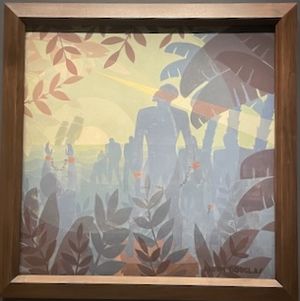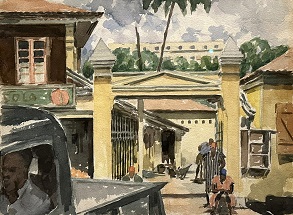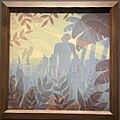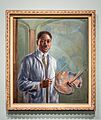Aaron Douglas (artist) facts for kids
Quick facts for kids
Aaron Douglas
|
|
|---|---|
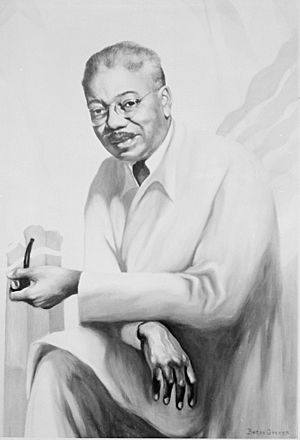
Portrait by Betsy Graves Reyneau
|
|
| Born | May 26, 1899 Topeka, Kansas, United States
|
| Died | February 2, 1979 (aged 79) Nashville, Tennessee, United States
|
| Nationality | American |
| Education | University of Nebraska, Teachers College, Columbia University |
| Alma mater | University of Nebraska; Columbia University Teacher’s College |
| Known for | Painting, Illustration, Murals |
| Style | Jazz Age, Modernism, Art Deco |
| Movement | Harlem Renaissance |
Aaron Douglas (born May 26, 1899 – died February 2, 1979) was an important American painter, illustrator, and art teacher. He was a key artist during the Harlem Renaissance, a time when Black art, music, and literature thrived in Harlem, New York.
Douglas became known for his murals and illustrations. His art often showed social issues like race and segregation in the United States. He used images inspired by African culture in his work. Aaron Douglas helped open doors for young Black artists in public art through his work with the Harlem Artists Guild. In 1944, he started the Art Department at Fisk University in Nashville, Tennessee. He taught art there until he retired in 1966. Douglas is seen as a major leader in modern African-American art, and his work inspired many artists after him.
Contents
Early Life and Education
Aaron Douglas was born and grew up in Topeka, Kansas. His birthday was May 26, 1899. His father, Aaron Douglas Sr., was a baker, and his mother, Elizabeth Douglas, was a homemaker and artist. Aaron loved art because he admired his mother's drawings.
He went to Topeka High School and graduated in 1917. After high school, Douglas moved to Detroit, Michigan. He took free art classes at the Detroit Museum of Art. In 1918, he started college at the University of Nebraska. He worked as a busboy to pay for his studies.
During World War I, Douglas tried to join the Student Army Training Corps (SATC) at the University of Nebraska. He was not accepted at first. He then went to the University of Minnesota for a short time and joined the SATC there. After the war ended, he returned to the University of Nebraska. He earned his Bachelor of Fine Arts degree in 1922.
After college, Douglas worked as a waiter for a short time. In 1923, he got a job teaching art at Lincoln High School in Kansas City, Missouri. He taught there until 1925. During this time, he dreamed of going to Paris, France, to continue his art studies, like many other artists.
Aaron Douglas's Art Career
Starting Out in Harlem (1925–1927)
In 1925, Aaron Douglas planned to stop in Harlem, New York, on his way to Paris. But he was convinced to stay in Harlem instead. This was during the peak of the Harlem Renaissance. He was inspired by the writer Alain Locke, who spoke about Harlem's importance for Black artists.
In Harlem, Douglas studied with Winold Reiss, a German portrait artist. Reiss encouraged him to use African themes in his art. This helped create a feeling of unity among African Americans. Douglas's work was even featured in Alain Locke's 1925 book, The New Negro.
Douglas worked with W. E. B. Du Bois, who was the editor of The Crisis. This was a monthly magazine for the NAACP. Douglas even became the art editor for a short time in 1927. He also created illustrations for Charles S. Johnson, the editor of Opportunity magazine. His drawings for these magazines often showed articles about lynching and segregation. They also featured theater and jazz. In 1927, Douglas painted his first mural at Club Ebony, showing Harlem nightlife.
Growing as an Artist (1928–1931)
In 1928, Douglas received a special fellowship from the Barnes Foundation in Philadelphia, Pennsylvania. This allowed him to study modern paintings and African art. That same year, he showed his work in an exhibition called "Contemporary Negro Art."
In the summer of 1930, Douglas moved to Nashville, Tennessee. There, he worked on a series of murals for the library at Fisk University. He described these murals as a "panorama of the development of Black people in this hemisphere." He also painted murals for the Sherman Hotel in Chicago, Illinois. Another important work was a mural for Bennett College for Women in Greensboro, North Carolina. This mural featured Harriet Tubman. In 1931, he spent a year in Paris, France, studying sculpture and painting.
Mural Masterpieces (1934–1936)
Douglas returned to Harlem in the mid-1930s to improve his mural painting skills. He began to explore more political topics in his art. In 1934, he was asked to paint a mural for the 135th Street YMCA in New York. He also created his most famous mural series, Aspects of Negro Life. This was for the Countee Cullen Branch of the New York Public Library.
Through these murals, Douglas taught people about the history of African Americans. The series of four murals showed a journey from an African setting to slavery and the Reconstruction era. It then moved through the challenges of lynching and segregation after the Civil War. The final mural showed the movement of African Americans north and the Harlem Renaissance. Douglas created a similar series, including Into Bondage (1936), for the Texas Centennial Exposition in Dallas in 1936.
During this busy time, Douglas also served as president of the Harlem Artists Guild in 1935. This group helped young artists in New York City by offering support and inspiration during the Harlem Renaissance.
Teaching and Later Years (1937–1979)
In 1937, Douglas received a travel fellowship to visit Black universities in the American South. These included Fisk University and the Tuskegee Institute. In 1938, he received another fellowship to visit the Dominican Republic and Haiti. There, he created watercolors showing life on these Caribbean islands.
When he returned to the United States in 1940, he worked at Fisk University. He also studied at Columbia University Teacher’s College in New York City. He earned his Master of Arts degree in 1944. After that, he moved to Nashville to start and lead the Art Department at Fisk University.
As a professor, he also started the Carl Van Vechten Gallery of Fine Arts. This gallery included both White and African-American art. Douglas used his experiences from the Harlem Renaissance to inspire his students. He encouraged them to learn about African-American history. This helped them understand why African-American art was so important in a mostly White-American society. Douglas retired from teaching at Fisk University in 1966.
Aaron Douglas passed away in Nashville on February 2, 1979, at the age of 79.
Aaron Douglas's Artistic Style
Aaron Douglas developed a unique art style. He combined modern art ideas with traditional African art. He was influenced by his teacher, Winold Reiss, to use African themes. This helped connect Africans and African Americans through art.
His art is often described as abstract. He showed the shared experiences of African-American people through images of song, dance, and poetry. In his murals and illustrations, he addressed social issues like race and segregation. He was one of the first Black artists to use African-centered images in his work.
Douglas's human figures are often flat and angular, with slits for eyes. His female figures are sometimes shown crouching or dancing in a traditional African way. He used elements from West African masks and sculptures. He also used a technique called cubism to simplify his figures into lines and shapes.
He used a limited range of colors, often greens, browns, purples, and blacks. His human figures were usually darker shades of the colors in the painting. He created strong feelings in his art with subtle color changes. He often used circles that got bigger and bigger to make viewers focus on a certain part of the painting.
His artwork is two-dimensional, meaning it looks flat. His human figures often don't have clear faces. This made them symbolic and general, helping to create a sense of unity between Africans and African Americans. Douglas's paintings also include see-through shapes. These shapes showed the struggles and successes of African Americans in society. His work is special because it links African Americans to their African heritage through art.
Important Works by Aaron Douglas
- Illustrations for The Crisis magazine (February and May 1926 issues)
- Mural at Club Ebony, 1927
- Illustrations for Paul Morand's book, Black Magic, 1929
- Harriet Tubman, a mural at Bennett College, 1930
- Symbolic Negro History, murals at Fisk University, 1930
- Dance Magic, murals for the Sherman Hotel, Chicago, 1930–31
- Illustrations and paintings for James Weldon Johnson’s book, God’s Trombones: Seven Negro Sermons in Verse, including:
- Let My People Go, around 1935–39
- The Judgment Day, created in 1939
- A series of four murals commissioned in 1934 by the Works Progress Administration:
- The Negro in an African Setting, shows African cultural dances and music, highlighting the heritage of African Americans.
- Slavery through Reconstruction, shows the difference between the promise of freedom and the political changes after the Civil War, and the problems of the Reconstruction era.
- The Idyll of the Deep South, shows how African-American song and dance continued despite the cruelty of lynching and other threats.
- Song of the Towers, shows three events in U.S. history from an African-American point of view: the movement of Black people north in the 1910s, the rise of the Harlem Renaissance in the 1920s, and the Great Depression in the 1930s.
- A four-part mural series (including Aspiration) at the Texas Centennial Exposition, 1936
- Illustrations in books like Countee Cullen's Caroling Dusk and Alain Locke's The New Negro.
Where to See His Art
- Let My People Go, Metropolitan Museum of Art, New York City
- The Judgment Day, National Gallery of Art, Washington DC
- The Founding of Chicago, Spencer Museum of Art, Lawrence, KS
- Study for "Aspects of Negro Life: From Slavery Through Reconstruction", Baltimore Museum of Art, Baltimore, MD
Legacy and Exhibitions

Aaron Douglas was a pioneer in the African-American modernist art movement. He combined modern art ideas with ancient African traditions. He helped future Black artists use elements of African and African-American history, along with themes of race in society.
In 2007, the Spencer Museum of Art put together a special exhibition called Aaron Douglas: African-American Modernist. It traveled to several cities, including Nashville, Washington, D.C., and New York. A detailed book about this exhibition was also created.
Douglas's work was also featured in the 2015 exhibition We Speak: Black Artists in Philadelphia, 1920s-1970s.
In 2016, when the National Museum of African American History and Culture opened, they made an archive of Aaron Douglas's artworks available online. You can find information about his art there, including when it was made and where it is now.
Images for kids
-
Portrait of Douglas by Edwin Harleston (1930)
See also
 In Spanish: Aaron Douglas para niños
In Spanish: Aaron Douglas para niños


